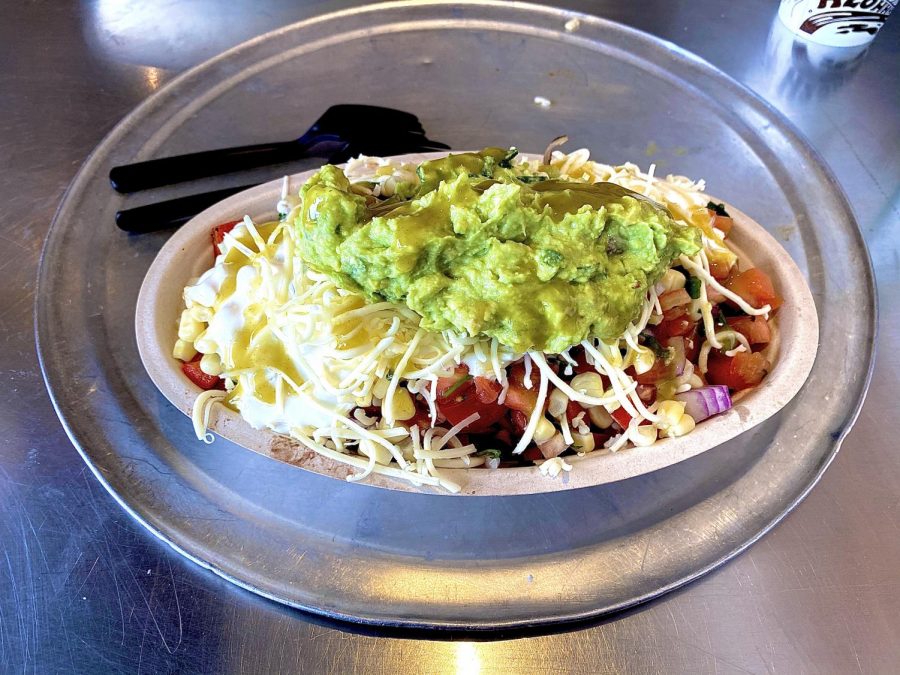Chipotle: Is It Actually Healthy?
My typical Chipotle bowl whenever I get the chance to visit. Does the health information nudge you to change your Chipotle order in any way?
February 3, 2020
Chipotle is personally one of my favorite places to indulge in at any time of the day, breakfast, lunch, and dinner. Many would call it an obsession; I call it a commitment. Loved by many, Chipotle is considered a fast-casual food chain. “Fast-casual” restaurants are places that offer higher quality food than fast-food chains, but don’t offer full table service. However, many wonder if the company is actually good for your health.
There are pros and cons to the affair. On one side, Chipotle can be a good part of your diet thanks to the highly customizable menu, or it can be completely counterproductive. Overall, it all depends on your choices. Having total control of what goes in your body can improve weight loss, muscle gain, and help you towards your goals. According to Lisa Mostovitz, RD, CDN, founder of The NY Nutrition Group, “Chipotle can be pretty healthy because they have veggies and lean protein.” This is, indeed, a fact. Chipotle provides you with ingredients like steak, chicken, fajita veggies, tomato/corn salsa, and black/pinto beans. Keri Gans, RD, CDN, author of The Small Change Diet, said that this is a good thing. Gans explains that “bulking” up your meals with vegetables is something that must be done daily. Also, most of the proteins, excluding the carnitas and sofritas, are lean and don’t retain much fat.
“The ingredients themselves are all fairly healthy choices—nothing is really bad in and of itself,” says Mostovitz.
However, though Chipotle has many ingredients that are fresh and fiber-packed, it also contains many calories and sodium. For example, though most of us can’t resist the sour cream and queso, it’s also filled with fat and excess salt. Chipotle also tends to over do it with the carb intake. White rice can either make or break a calorie surplus for little fiber. Also, a single burrito-sized tortilla is 320 calories with only 3 grams of fiber. Gans says that if you want to make your Chipotle meal between the 400-500 calorie range, adding a tortilla is not the way to go. With the tortilla, you have little room in your number of calories to add nutrient-rich foods while staying in between that range. In addition, it’s also dangerously easy to over-eat. No matter if you have the advantage of building your meal, the “serving” at Chipotle is larger than one portion size. This is significantly true when it comes to the white rice. Usually the amount served to you is, if not two, three times more than you actually need.
Now, for the million dollar question: is Chipotle a healthy option?
The answer? Yes…and no. Chipotle can definitely be a healthy part of your diet if done properly, or it can be a wave pool of extra, unneeded calories. It all depends on the choices you make. This is the way experts recommend you get your next meal:
- Don’t give into the burrito. Instead, op for a salad or a burrito bowl in order to boost your vegetable intake rather than too many carbs.
- Cut back on rice. A small amount of rice is perfectly fine. However, the normal serving given is too much for one person. White rice at Chipotle contains 210 calories with 40 grams of carbs. “If you want to do the rice that’s okay, but I would ask for half a normal portion and then skip the chips on the side,” Moskovitz says. Instead of rice, op for beans as your base instead. Beans are not only delicious, but have about half the carbs and calories as rice. While the calories may still add up, legumes are fiber-packed and low in saturated-fat. They also give you 8 grams of added protein, perfect for those who are vegetarian or vegan who don’t get their proteins from meat.
- Be careful with your added toppings. Pass on the sour cream and queso. If you are in need for a creamy/rich topping, go for half a serving of guac. Though guac is high in calories, it has much needed healthy fats thanks to avocados. The salsas are great options that are both delicious and low-calorie. They’re also high in vitamins and minerals. Gans says she’s a “big fan” of the salsas. Her favorites being the fresh tomato and the green tomatillo.
- Watch your serving size. For the last recommendation, watch out for those pesky serving sizes. Gans recommends getting a kids meal, because you get a smaller portion while not sacrificing the ingredients you love. Another option, if you’re not loving the idea of ordering from the children’s menu, is to eat half of your food one day and pack it up for lunch for the next.
Here are some of the healthiest Chipotle meals or “recipes” you should get if you’re ever in a rush.
- “Chicken Salad Bowl.” Romaine lettuce, chicken, black beans, and green tomatillo salsa + fresh tomato salsa. Nutrition: 360 calories, 8.5 g of fat, 32 g of carbs (9 g fiber), 41 g of protein
- “Veggie Burrito Bowl.” Black beans, fajita veggies, guacamole, and fresh tomato salsa. Nutrition: 405 calories, 23.5 g of fat, 39 g of carbs (15 g fiber), 11 g of protein
- “Kids Tacos.” 2 flour tortillas + steak, pinto beans, romaine lettuce, and tomatillo red chili salsa. Nutrition: 375 calories, 9 g of fat, 47.5 g of carbs (10.5 g fiber), 21 g of protein
Though my meal is definitely not the epitome of perfect health, hopefully this information helps you find balance within your decisions between you and your good ol’ Chipotle.
*All recipes came from Prevention.com.
*All nutrition information based on Chipotle’s Nutrition Calculator.

